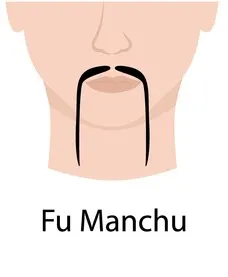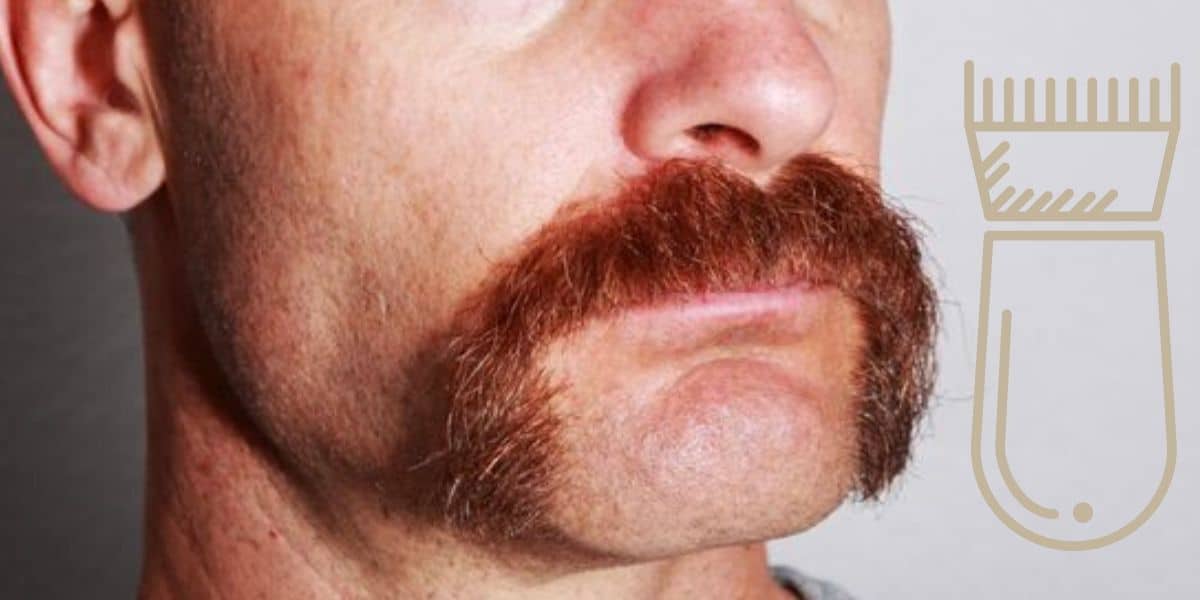These mustache styles are frequently confused. Although they aren’t equally as common nowadays, getting to grips with how they’re different is crucial.
You’re about to learn the main differences between the handlebar, horseshoe, and Fu Manchu mustaches.
Let’s get to it.
Handlebar Vs Horseshoe Mustache
The handlebar mustache is defined by the edges being curled upward on either side. In contrast, the horseshoe mustache consists of an inverted U-shape travelling around the sides of the mouth before abruptly ending at the jawline.
These two mustaches are an undeniably popular choice among the truly committed mustache aficionados.

Image From 123RF
However, even the seasoned ‘stache grower sometimes struggles to tell the difference between them.

Image From Deposit Photos
Key Differences
Here are the main ones to know about to comfortably distinguish between them every time.
1. Shape
Both the handlebar and the horseshoe are named after the items they resemble (or at least attempt to resemble).
The handlebar mustache is named as such because it consists of edges that are curved upwards.
In theory, this should sort of look like the handlebars of a motorcycle.
Most handlebar mustaches have the edges curved above the lip, but not always. Particularly long mustaches can have the edges curved parallel with or below the lip.
As long as the edges are curled upward, it doesn’t matter.
Although the definition of “handlebar” has broadened to include various very similar mustache styles such as the Imperial mustache, they all share this common feature.
Another common feature of the handlebar is that it’s often neatly parted at the philtrum, although this isn’t essential to its definition.
The horseshoe mustache also has a characteristic appearance, resembling an inverted “U” shape or a horseshoe.
The U-shape travels around the mouth and down the sides of the chin, often ending abruptly at the edge of the jawline. The sides look like two neat columns enclosing the mouth.
The tip of the chin itself is kept hair-free.
Unlike the handlebar mustache, the edges are not curled or curved whatsoever. The only key point with the edges is that they stop at the jawline and don’t extend down the neck.
2. Required Length
Simply put, a handlebar mustache will require more length than a horseshoe mustache.
The reason for this is that you need enough length to curl the edges of a handlebar mustache upwards.
Attempting to do so after just a few weeks of growth will be impossible – try it out for yourself.
Every man’s rate of facial hair growth is different, but you can expect a handlebar to take at least 10 to 12 weeks to come to its full form.
Before that point, the mustache can be gradually trained to curve upward, but it won’t be fully possible until you have enough growth.
In contrast, the horseshoe mustache doesn’t require quite as much length.
You could get away with having just 2 to 4 weeks of growth before defining the defiant columns of a horseshoe.
It would still be obvious that it looks like a horseshoe mustache.
The reason for this is that you aren’t curling the mustache and thus you don’t need enough length to do so.
You could even craft a horseshoe out of a heavy stubble beard and it would still look fine. It won’t look quite as impressive as Hulk Hogan’s, but it’ll be obvious that it’s a horseshoe nonetheless.
With both the horseshoe and the handlebar, the best way to start would be by growing a full beard.
Once you have enough length for either one of them, you could trim and snip away at the excess and sculpt your mustache of choice.
This makes facial hair often a lot more acceptable during the awkward growth phases. Trying to rock a lone mustache before the horseshoe or handlebar can fully take form will often look awkward.
Instead, grow out a full beard until you have enough length to really go all the way in on either of them.
How To Choose
Choosing between a horseshoe and handlebar can be a surprisingly difficult decision. Each of them brings something different to the table.
Here are three factors you should consider.
1. Maintenance
Ultimately, the handlebar is a higher maintenance style than the horseshoe.
The reason for this is that the handlebar requires more length to style. With any facial hairstyle, the longer it is, the tougher it’ll be to maintain.
With more length, you’ve got more of a need to oil, brush, comb, and snip flyaways and strays.
While horseshoes can be long as well, they don’t have to be long.
You’ll still need to trim it every few weeks and keep the U-shape defined. The edges will need to stop at the jawline and the neck and tip of the chin should be kept hair-free (i.e shaved).
But overall, horseshoes will still usually be shorter in length than handlebars and so will have a reduced maintenance requirement.
2. Growth Pattern
Horseshoe mustaches are dependent on the ability to grow thick facial hair down the sides of the chin.
This is that space between the corners of the mouth and the edge of the jawline.
Unfortunately, this is a notoriously patchy area of growth for many men. It’s why such a large number of men aren’t able to make their “beard connect”.
This is the area they’re talking about.
A common workaround for bearded men is to leave their goatee disconnected with a floating mustache and chin beard.
But for men looking to grow a horseshoe mustache, thick growth in this area is crucial to achieving the classic U-shaped appearance.
There really isn’t a workaround for this. It may be a shame, but if you struggle to grow hair in this area, there’s a good chance that the horseshoe may not be the style for you.
While the handlebar mustache does still require a relatively thick and full growth to adequately achieve the upward curls, you don’t require such thick growth in this problem area.
So, if you’re one of the many unfortunate aspiring mustachioed men struggling to grow hair here, the handlebar may be a reasonable alternative that you could actually achieve.
3. Face Shape
Although face shape is important when it comes to the choice of facial hair, it’s important not to dwell on it too much.
If you like one of these mustache styles, try it out regardless of your face shape. It’s why I left this factor until last – it’s the least important one.
However, it’s important to recognize that each of them may suit certain face shapes better than others. This is more noticeable with the handlebar.
The handles of the handlebar mustache have the effect of making the face appear a little wider. It can also add prominence to the cheekbones.
Of course, the longer the handles, the more pronounced this effect.
Men with longer face shapes would benefit more from this effect – this includes oblong, triangle, oval, and diamond face shapes.
Although it’s by no means a deal-breaker, men with shorter face shapes such as round or square may want to think twice or at least prevent the handles from extending too widely.
Horseshoe mustaches are a little more versatile when it comes to face shape. In fact, men with shorter face shapes (eg. round or square) may benefit from its ability to add length to the chin.
As the eyes are drawn down the columns on either side, they give the illusion of a longer face.
Once again, don’t take this to heart. I don’t want this to put off men with longer face shapes from growing the horseshoe.
But if you were struggling to choose between a handlebar and a horseshoe, your face shape may help to swing it for you either way.
Handlebar Vs Fu Manchu Mustache
The Fu Manchu mustache consists of two long tendrils originating at the corners of the upper lip and extending down beyond the chin. In contrast, the handlebar mustache is shorter and has the edges curled upward, often above the level of the lips.
It’s no secret that the handlebar is far more commonly seen than a Fu Manchu in both Western and Eastern culture.

Image From Deposit Photos
While the Fu Manchu is rarely seen outside of the television and movie industry, the handlebar mustache has remained a staple among mustache aficionados for many decades.

Image From Deposit Photos
Key Differences
Here are the main differences between the two discussed in more detail.
1. Shape
The key difference between the shape of the handlebar and the Fu Manchu comes down to the edges and the philtrum.
The edges of the handlebar are curled upward on either side, resembling the handlebar of a motorcycle. These curls usually extend above the level of the upper lip (although not always).
In contrast, the edges of the Fu Manchu extend down straight – past the corners of the mouth and often beyond the chin as well.
They’re often called “tendrils”.
The other key difference between the handlebar and the Fu Manchu is the philtrum. This is the middle part above the upper lip.
Contrary to popular understanding, with the Fu Manchu, the upper lip is actually shaved clean in the centre.
The “tendrils” I described above originate from the sides of the upper lip. In other words, you don’t have growth extending all the way across the upper lip as you would with the Handlebar.
2. Required Length
While both of these mustache styles require long facial hair to style, the Fu Manchu will require more.
The handlebar mustache needs around 10 to 12 weeks of growth in order to curl the edges of the mustache upward.
The long tendrils of the Fu Manchu often extend well beyond the chin. Although this isn’t a necessity, it’s a common feature of the overall aesthetic.
It may sound obvious, but to achieve this, you’ll need enough length.
How much length you need will depend on how far down you want the tendrils to extend.
However, it’s a pretty safe bet to say that you’ll most likely need more length than you would for a handlebar.
How To Choose
These two styles are so different in appearance that it usually isn’t difficult to choose between them.
However, if you were on the fence, here are two factors you should consider before making your decision.
1. Attention
First of all, the Fu Manchu hasn’t developed the best of reputations. It has been called culturally insensitive by some. As such, it’s rarely seen outside of television and movies.
This is the first thing you should consider. Although the debate around this rages on, in general, it’s best to avoid the Fu Manchu for this reason alone.
But let’s discuss each style in isolation of this important fact.
Both the handlebar and the Fu Manchu are pretty attention-grabbing styles. They aren’t quite as common as a straightforward Chevron.
The rarer a style is, the more attention it’ll draw.
While the sharply defined curls of a handlebar do definitely catch the eye, they aren’t quite as eye-catching as the long tendrils of the Fu Manchu.
In fact, it’ll be practically impossible to go about your day without a few stares and the occasional comment when you’ve gone for a Fu Manchu.
It’s just so uncommon that it’s hard to avoid this.
The handlebar, on the other hand, is common enough to avoid this for the most part. It will still most likely be the first thing people notice when they see your face.
But it’s unlikely to generate the same sort of attention that a Fu Manchu has.
If you aren’t hoping for your mustache to define your entire look, a handlebar may be more appropriate.
2. Maintenance
Both of these mustache styles are pretty high maintenance.
That’s mainly because they’re pretty long styles. With longer facial hair, you’ve got additional requirements including oiling, combing, balming, etc.
Not everyone will stick to these grooming habits, but longer facial hair will usually benefit from it.
The handlebar will also usually need a small amount of wax to keep those curled edges in place. While oiling is worth doing, it doesn’t have any hold.
If you want those curls to stay in place throughout the course of the day, a small amount of wax will be necessary.
But that’s about where it ends for the handlebar.
With the Fu Manchu, the long tendrils are tapered, straight, and smooth. They’re well defined and this takes some effort.
But it’s the length that makes the Fu Manchu such a tough style to maintain – even more so than the handlebar.
In addition, the upper lip is shaved in the center to keep the tendrils separated. This is an extra bit of grooming that will need to be considered as well.
Overall, the Fu Manchu is tougher to maintain than the handlebar. If this is important to you, don’t neglect it when making your decision.
Conclusion
Understanding the difference between similar mustache styles is the key to forging out your ideal aesthetic.
You don’t necessarily need to stick to the strictest definitions of a specific mustache style. There’s plenty of scope for experimentation.
Either way, use this knowledge to sculpt out of your ideal stache and stick to it for the long haul.
Enjoy.
Ready Sleek founder. Obsessed with casual style and the minimalist approach to building a highly functional wardrobe. Also a fan of classic, vintage hairstyles.







